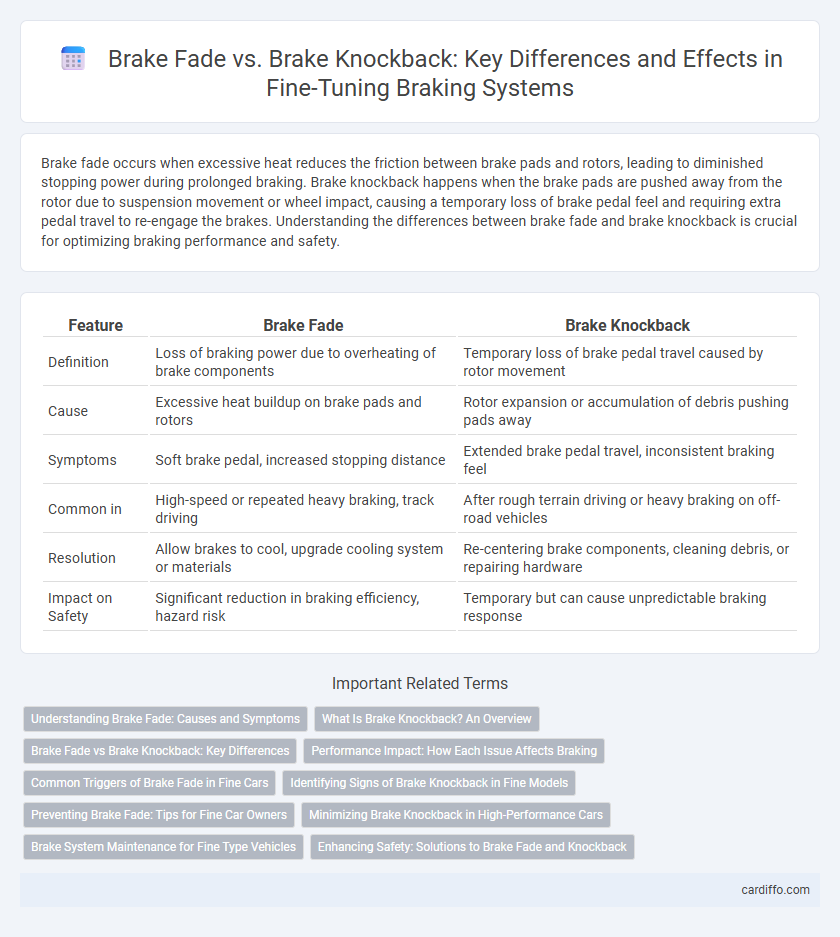Brake fade occurs when excessive heat reduces the friction between brake pads and rotors, leading to diminished stopping power during prolonged braking. Brake knockback happens when the brake pads are pushed away from the rotor due to suspension movement or wheel impact, causing a temporary loss of brake pedal feel and requiring extra pedal travel to re-engage the brakes. Understanding the differences between brake fade and brake knockback is crucial for optimizing braking performance and safety.
Table of Comparison
| Feature | Brake Fade | Brake Knockback |
|---|---|---|
| Definition | Loss of braking power due to overheating of brake components | Temporary loss of brake pedal travel caused by rotor movement |
| Cause | Excessive heat buildup on brake pads and rotors | Rotor expansion or accumulation of debris pushing pads away |
| Symptoms | Soft brake pedal, increased stopping distance | Extended brake pedal travel, inconsistent braking feel |
| Common in | High-speed or repeated heavy braking, track driving | After rough terrain driving or heavy braking on off-road vehicles |
| Resolution | Allow brakes to cool, upgrade cooling system or materials | Re-centering brake components, cleaning debris, or repairing hardware |
| Impact on Safety | Significant reduction in braking efficiency, hazard risk | Temporary but can cause unpredictable braking response |
Understanding Brake Fade: Causes and Symptoms
Brake fade occurs when the braking system overheats, reducing friction between the brake pads and rotors, which diminishes stopping power. Common causes include prolonged downhill driving, repeated hard braking, and excessive heat buildup in the brake components. Symptoms of brake fade consist of a spongy brake pedal, increased stopping distances, and reduced pedal responsiveness.
What Is Brake Knockback? An Overview
Brake knockback occurs when the brake pedal pushes further toward the floor after initial application, caused by the pistons retracting in the caliper due to wheel or suspension movement. This phenomenon reduces immediate braking effectiveness, as it requires additional pedal travel to reapply pressure. Brake knockback is commonly experienced in high-performance or racing vehicles where aggressive suspension dynamics affect caliper and rotor positioning.
Brake Fade vs Brake Knockback: Key Differences
Brake fade occurs when the braking system overheats, causing a temporary loss of stopping power due to reduced friction between the brake pads and rotors. Brake knockback refers to the rotor pushing the brake pads away from the caliper pistons after hard braking, resulting in increased pedal travel before the brakes re-engage. Understanding the key differences between brake fade and brake knockback is essential for diagnosing brake performance issues and ensuring optimal vehicle safety.
Performance Impact: How Each Issue Affects Braking
Brake fade significantly reduces braking performance during prolonged or intense use by causing a loss of friction due to heat buildup, leading to longer stopping distances and decreased pedal responsiveness. Brake knockback, caused by rotor movement or caliper displacement, results in a temporary increase in pedal travel and reduced brake effectiveness, requiring additional pedal effort to re-engage braking power. Both issues compromise safety, but brake fade primarily impacts sustained braking performance while knockback affects immediate brake response.
Common Triggers of Brake Fade in Fine Cars
Brake fade in fine cars commonly occurs due to excessive heat buildup from prolonged or intense braking, which degrades brake pad material and reduces friction efficiency. Contaminants such as oil, dust, or moisture on brake components can also trigger brake fade by impairing pad and rotor contact. Improper brake system maintenance, including worn pads, low brake fluid, or compromised cooling, further increases the risk of brake fade in high-performance vehicles.
Identifying Signs of Brake Knockback in Fine Models
Brake knockback in fine models manifests as a sudden loss of brake pedal firmness and increased pedal travel after aggressive driving or rapid repeated braking. Unlike brake fade, which occurs gradually due to overheating of brake components, knockback results from the displacement of brake pads, causing the caliper pistons to retract slightly. Key signs include a spongy brake pedal feel and the need to pump the pedal to restore normal braking pressure.
Preventing Brake Fade: Tips for Fine Car Owners
Preventing brake fade in fine cars requires maintaining optimal brake fluid levels and using high-quality, heat-resistant brake pads designed for performance vehicles. Regularly inspecting brake components for wear and ensuring proper cooling airflow around the brakes can significantly reduce the risk of overheating and fading during intense driving conditions. Fine car owners should also avoid excessive braking on steep descents by employing engine braking techniques to preserve brake effectiveness and extend component lifespan.
Minimizing Brake Knockback in High-Performance Cars
Minimizing brake knockback in high-performance cars involves using high-quality brake components such as multi-piston calipers and advanced pad materials that resist excessive pad retraction. Ensuring proper caliper piston seals and installing dust boots help maintain consistent pad positioning under repeated heavy braking. Regular inspection and upgrading to performance rotors designed for heat dissipation further reduce the risk of brake knockback during aggressive driving.
Brake System Maintenance for Fine Type Vehicles
Brake fade occurs when excessive heat reduces the friction between brake pads and rotors, leading to diminished stopping power in fine type vehicles. Brake knockback involves the displacement of brake pads from the rotor due to suspension or wheel movement, causing increased pedal travel and delayed brake response. Regular brake system maintenance, including inspection of brake pads, rotors, and fluid levels, is essential to prevent these issues and ensure optimal braking performance.
Enhancing Safety: Solutions to Brake Fade and Knockback
Enhancing safety involves addressing brake fade and brake knockback through advanced braking systems such as ventilated disc brakes and high-friction brake pads. Implementing thermal coatings and improving brake cooling technology reduces heat buildup, minimizing brake fade during prolonged use. Regular maintenance and brake system inspections ensure optimal performance, preventing knockback by maintaining proper caliper function and brake pad alignment.
Brake fade vs Brake knockback Infographic

 cardiffo.com
cardiffo.com